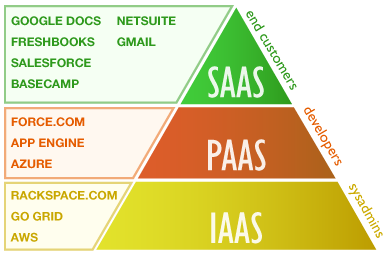IaaS vs SaaS vs Paas: The Differences
As you are probably already aware, the cloud computing is becoming more and more popular. It offers multiple benefits over other types of computing, which makes it perfect for bespoke software development, but also for communication with the clients. When it comes to the cloud services that this kind of computing has to offer, there are three of them. Those are SaaS PaaS IaaS. These services seem complex and difficult to understand for many people, which is why we are going to make a SaaS IaaS PaaS comparison, and see what the differences between these three types are.

SaaS
The first thing that you need to know about SaaS is that it stands for Software-as-a-Service. This is the type of cloud computing that regular users come in contact with on daily basis, and that is relatively known to everyone. This is the type that doesn't require the user to buy the program or an app and then download it in order to use it.
Instead, it is expected that the user will interact with the software on the internet, via their browser. Due to its practical use and simplicity, this is the most popular of three types of cloud computing. It offers many different kinds of software, which includes social networks like Twitter or Facebook, email services like Gmail, and even services like ezTalks Video Conferencing.
Basically, this type functions by delivering the already developed software directly to the user online. The user has minimal responsibilities, and everything concerning the service itself (like updating, securing, and alike) is the responsibility of the vendor. The user also has minimal freedom when using SaaS, and they can't affect the quality of service in any way.
PaaS
PaaS is the second of the three types of cloud computing, and it stands for Platform-as-a-Service. This is a more complex type of cloud computing, and it provides users with much more freedom, but it also requires more knowledge from the user. Its popularity is growing rapidly, but it is still not as widely used as SaaS.
You can think of it as a clear platform that offers some basic functions that user can use, like an operating system, hardware, and the network. This makes it excellent when it comes to designing and creating your own apps. It is also often used for the purpose of hosting, and it works equally as good for both companies (large or small) and individuals.
As mentioned, the PaaS and SaaS difference is that PaaS allows users much more freedom to do different things on the platform. Where SaaS creates everything and provides users with finished products, PaaS allows users to choose or develop that product themselves.
IaaS
Finally, we have the third and most complex type of cloud computing - IaaS. It stands for Infrastructure-as-a-Service, and it works by giving its user a virtualized platform. Users are provided with the network, data center, software, and servers.
This is the most basic type of service, and all that the user has is the space that they can access via the network. That means that they have complete freedom to organize this space as they see fit. This includes the software, apps, and even the entire operating system of their choice.
Components like data centers, servers, and storage system do come as a part of the deal, but the rest is up to the user. Naturally, this allows multiple advantages, even when compared to PaaS, but it also brings more responsibility, and it requires more knowledge concerning how everything works.
IaaS vs SaaS vs PaaS
These three types can also be seen as three stages of cloud computing. IaaS is the most basic one, where everything is up to the user and their own desire. They get the space and some of the most basic software.
PaaS provides its user with complete tools, that the user can combine into creating something even more complex. Also, they have a certain amount of freedom to organize the space they got in a manner of their choosing.
Finally, there is SaaS, where the user gets to use the final 'product'. This is the type of service where the user can't develop or impact pretty much anything on the platform. However, that also means that the user is relieved of responsibility when it comes to keeping an eye on the software development. They can simply enjoy the already finished software, without the need to maintain it, create backups, or keep it stable, which is the biggest difference between SaaS and the other two.